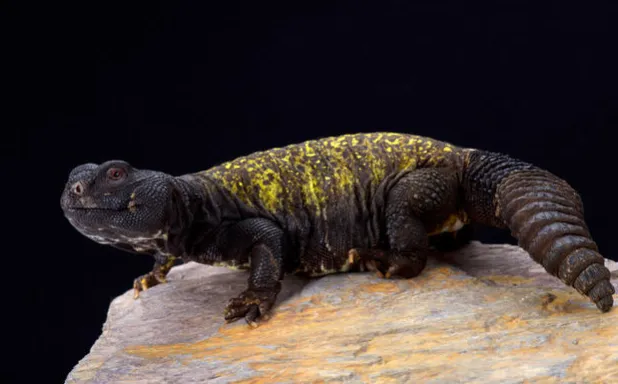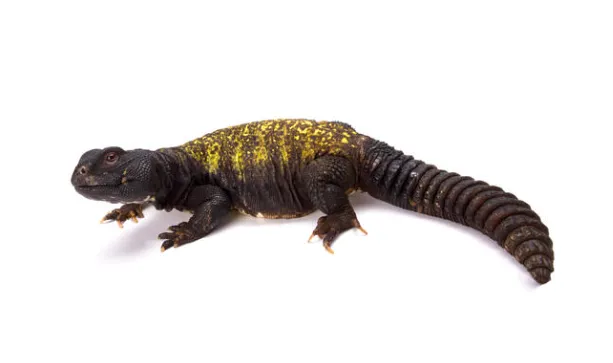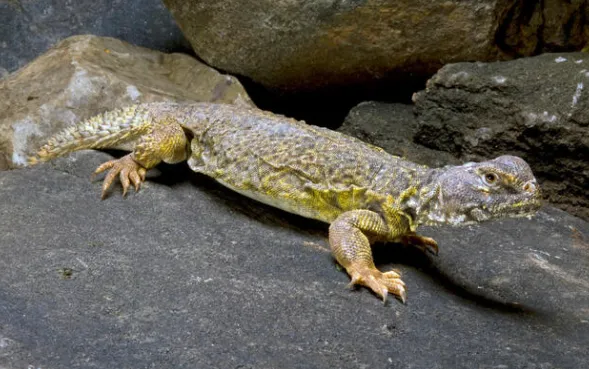
Table of Contents
Diet
Q: What is the natural diet of Mali uromastyx in the wild?
A: In the wild, Mali uromastyx primarily eat a wide variety of plants, seeds, and flowers. Their diet consists mostly of leafy greens and local vegetation, given the arid environments they inhabit.
Q: Are Mali uromastyx strictly herbivorous?
A: Yes, Mali uromastyx are primarily herbivorous. While they might occasionally consume insects in the wild, their main diet consists of plants, seeds, and flowers.
Q: How often should I feed my Mali uromastyx?
A: Adult Mali uromastyx should be fed daily with a diet primarily consisting of leafy greens, supplemented with seeds, flowers, and occasional vegetables.
Q: Which vegetables are best for Mali uromastyx?
A: Vegetables such as dandelion greens, collard greens, mustard greens, and escarole are great choices. Avoid iceberg lettuce, as it lacks nutritional value.
Q: Can Mali uromastyx eat fruits, and if so, which ones?
A: Fruits can be offered occasionally, in moderation. Suitable fruits include figs, melon, berries, and apples. Avoid citrus fruits.
Q: What types of seeds can Mali uromastyx consume?
A: Mali uromastyx can eat seeds like millet, lentils, and birdseed mixes.
Q: Do Mali uromastyx require calcium or other vitamin supplements in captivity?
A: Yes, it’s essential to dust their
Q: How important is hydration in the Mali uromastyx diet?
A: While they get most of their hydration from their
Q: Should I feed my Mali uromastyx insects?
A: Insects aren’t a necessary part of their diet in captivity, and they primarily thrive on a herbivorous diet. If offered, it should be very occasional.
Q: How can I ensure a varied diet for my Mali uromastyx?
A: Rotate through various leafy greens, vegetables, seeds, and occasional fruits. A diverse diet ensures they get all necessary nutrients.
Q: Are commercial uromastyx diets suitable for Malis?
A: While some commercial diets can supplement their primary
Q: Which foods are toxic or harmful to Mali uromastyx?
A: Avoid avocado, rhubarb, and citrus fruits, as these can be toxic. Also, minimize or eliminate high-oxalate foods like spinach and beet greens.
Q: What portion size is appropriate for an adult Mali uromastyx?
A: A portion size roughly equivalent to the size of their head should suffice, but always adjust based on your individual lizard’s needs and appetite.
Q: Is it safe to offer Mali uromastyx flowers? Which ones?
A: Yes, flowers like hibiscus, dandelion, and rose petals (pesticide-free) can be offered occasionally.
Q: How do I ensure the plants and veggies I feed are free from pesticides?
A: Wash all fresh
Q: How can I tell if my Mali uromastyx is getting proper nutrition?
A: A well-nourished Mali uromastyx will be active, have bright eyes, clear skin, a healthy appetite, and regular bowel movements.
Q: Are there any specific legumes or grains that Mali uromastyx prefer?
A: Mali uromastyx can consume lentils, chickpeas, and other legumes in moderation. However, their main diet should still focus on leafy greens.
Q: Should I provide a water dish, or will dietary hydration suffice?
A: While they get most of their hydration from
Q: What are signs of overfeeding or obesity in Mali uromastyx?
A: Overweight uromastyx may have rolls or folds in their skin, less defined body shape, and may become lethargic.
Q: How can I determine if my Mali uromastyx has a nutritional deficiency or diet-related issue?
A: Signs might include lethargy, refusal to eat, irregular bowel movements, or physical symptoms like soft bones indicating metabolic bone disease. Always consult with a veterinarian if you suspect health issues.

Habitat
Q: What type of enclosure is best for Mali uromastyx?
A: A well-ventilated glass or wooden terrarium with a screen top is best for Mali uromastyx. This allows for proper heat retention while also ensuring adequate ventilation.
Q: How large should a Mali uromastyx terrarium be?
A: Adult Mali uromastyx require a spacious enclosure, with a minimum size of 4x2x2 feet. Juveniles can be housed in smaller enclosures, but they grow quickly, so it’s essential to upgrade as they mature.
Q: What is the ideal temperature gradient for a Mali uromastyx habitat?
A: Mali uromastyx require a warm environment. The basking spot should be between 100-110°F, while the cooler end should stay between 80-90°F. Night temperatures can drop to the mid-70s.
Q: Do Mali uromastyx require UVB lighting?
A: Yes, Mali uromastyx benefit from UVB lighting, which helps them synthesize vitamin D3 and properly metabolize calcium. A 10-12% UVB bulb is recommended.
Q: Which substrate is best for Mali uromastyx enclosures?
A: A mixture of play sand and organic topsoil is often recommended. This allows the lizard to burrow and helps maintain proper humidity levels.
Q: How can I provide proper basking spots for my Mali uromastyx?
A: Use a high-quality basking bulb or a ceramic heat emitter placed over a flat rock or elevated platform to create a basking spot.
Q: How often should I clean the Mali uromastyx terrarium?
A: Spot clean the enclosure daily for feces or uneaten
Q: How do I maintain the appropriate humidity level for Mali uromastyx?
A: Mali uromastyx come from arid environments, so they don’t require high humidity. However, a level of around 20-30% should be maintained. Overhead misters or manual misting can help, but avoid making the enclosure too damp.
Q: What types of hides or shelters are preferred by Mali uromastyx?
A: They need multiple hides – one in the warmer end and another in the cooler end. Commercial reptile caves, or homemade hides using rocks or clay pots, are suitable.
Q: Can live plants be used in Mali uromastyx enclosures?
A: While live plants can be used, they’re not necessary. If used, choose hardy desert plants like succulents. Ensure they’re pesticide-free.
Q: What kind of equipment do I need to monitor the terrarium environment?
A: Invest in high-quality digital thermometers and hygrometers to monitor the temperature and humidity levels accurately.
Q: How do I ensure proper ventilation in the Mali uromastyx habitat?
A: Using a terrarium with a mesh or screen top ensures proper ventilation, promoting air circulation and preventing excessive humidity.
Q: Can I house multiple Mali uromastyx in the same terrarium?
A: It’s possible, but caution is advised. Males can be territorial, so it’s often best to house them individually. If housing together, ensure the terrarium is spacious with multiple basking spots and hides.
Q: How can I replicate the desert environment of Mali uromastyx in captivity?
A: Use desert-themed substrates, provide proper heat and UVB lighting, incorporate desert plants (real or fake), and offer plenty of hiding and basking spots.
Q: What are the best climbing structures or decorations for a Mali uromastyx enclosure?
A: While they’re not avid climbers, Mali uromastyx appreciate some elevation. Flat rocks, low branches, and cork bark are all good choices.
Q: How do I provide a burrowing area for my Mali uromastyx?
A: Ensure the substrate is deep enough (at least 4-6 inches) and slightly moist to allow for burrowing behavior.
Q: Can I keep a Mali uromastyx in an outdoor enclosure?
A: Yes, but ensure it’s secure, provides proper temperature ranges, and protects the lizard from predators. Outdoor housing is usually best for short periods or in climates mimicking their natural habitat.
Q: What are the potential hazards to avoid in a Mali uromastyx habitat?
A: Avoid sharp or rough decorations that could cause injuries, ensure heating elements cannot burn the lizard, and prevent small items that could be ingested accidentally.
Q: How do I set up a water source in a Mali uromastyx enclosure?
A: While they get most of their hydration from their diet, a shallow water dish can be provided. Ensure it’s not too deep to prevent drowning.
Q: Are there specific materials or decorations to avoid in a Mali uromastyx’s habitat?
A: Avoid using pine or cedar substrates, as these can be toxic. Also, stay away from heat rocks, which can cause burns, and ensure any decorations are free from sharp edges or small parts that can be ingested.

Behavior
Q: How do Mali uromastyx communicate?
A: Mali uromastyx primarily communicate through body language. This can include color changes, tail wagging, head bobbing, and displaying their dewlap. Some of these behaviors signal territory, readiness to mate, or feeling threatened.
Q: Why is my Mali uromastyx digging in its enclosure?
A: Digging is a natural behavior for uromastyx, as they are burrowers in the wild. They dig to create hiding spots, to feel secure, and to regulate their temperature by seeking cooler spots below the surface.
Q: Are Mali uromastyx territorial?
A: Yes, Mali uromastyx can be territorial, especially males. They might display territorial behaviors like head bobbing, tail wagging, or even aggression when their territory is invaded or threatened.
Q: Is it normal for Mali uromastyx to bask for extended periods?
A: Absolutely. As desert dwellers, Mali uromastyx bask in the sun for long periods to regulate their body temperature. This behavior is replicated in captivity under basking lights.
Q: Do Mali uromastyx recognize their owners?
A: While it’s believed that uromastyx do not recognize owners in the same way mammals might, they can become accustomed to a caretaker’s presence and handling over time, becoming more docile and less stressed.
Q: Why does my Mali uromastyx wag its tail?
A: Tail wagging can be a sign of being threatened or feeling defensive. It’s a warning sign to potential predators or threats.
Q: How active are Mali uromastyx during the day?
A: Mali uromastyx are diurnal, meaning they’re active during the day. Their activities include basking, exploring, digging, and searching for
Q: Are Mali uromastyx aggressive?
A: While generally not aggressive, they can become defensive if they feel threatened. Males can also exhibit aggressive behaviors during mating season or when defending their territory.
Q: Why is my Mali uromastyx hiding so much?
A: Hiding is a natural behavior, providing them with a sense of security. Excessive hiding could be due to stress, incorrect environmental conditions, or illness.
Q: How do Mali uromastyx interact with other reptiles?
Ar: Uromastyx can be territorial and might not always get along with other reptiles, especially if they feel their territory is threatened. Introducing them to other species requires caution and proper research.
Q: Can you handle a Mali uromastyx?
A: Yes, with patience and consistent, gentle handling, they can become more accustomed to human interaction. However, always approach with care and avoid stressing the animal.
Q: Do Mali uromastyx have specific mating behaviors?
A: Yes. Males may display more vibrant colors, wag their tails, and bob their heads. There might be chasing or circling between potential mates.
Q: Why is my Mali uromastyx changing color?
Ar: Uromastyx can change color based on their mood, temperature, or health. It’s a form of thermoregulation and communication.
Q: How do Mali uromastyx show stress or discomfort?
A: Signs include frequent hiding, refusal to eat, rapid breathing, darkened coloration, and aggressive behavior.
Q: Can Mali uromastyx cohabitate with other Mali uromastyx or other species?
A: While it’s possible for some to cohabitate, especially if introduced at a young age, it’s essential to monitor for signs of stress or aggression. Cohabitation with other species is generally not recommended.
Q: How often do Mali uromastyx shed their skin?
A: Like other reptiles, they shed their skin periodically, especially as they grow. The frequency varies but can be influenced by factors like diet, health, and environmental conditions.
Q: What does head-bobbing mean in Mali uromastyx?
A: Head bobbing can be a sign of dominance, territorial display, or mating behavior.
Q: Why is my Mali uromastyx trying to escape its enclosure?
A: This can be due to stress, dissatisfaction with the environment, or a simple natural curiosity. Ensure the habitat is appropriately enriched and meets their needs.
Q: Is there a difference in behavior between male and female Mali uromastyx?
A: Males tend to be more territorial, especially during mating seasons. They might also have more vibrant color displays compared to females.
Q: Do Mali uromastyx vocalize or make any sounds?
A: While not particularly vocal, Mali uromastyx might make huffing or hissing sounds when they feel threatened or are stressed.

Health and Wellness
Q: How long can a Mali uromastyx live in captivity?
A: With proper care, a Mali uromastyx can live for 15-30 years.
Q: What is the ideal temperature for a Mali uromastyx enclosure?
A: The basking area should range between 120-130°F (49-54°C), while the cooler end should be around 85-90°F (29-32°C).
Q: How often should I feed my Mali uromastyx?
A: Adults can be fed every other day, while juveniles should be fed daily.
Q: Why is my Mali uromastyx not eating?
A: This can be due to several reasons, including stress, temperature imbalances, illness, or even the presence of unsuitable
Q: How do I ensure adequate humidity for my Mali uromastyx?
A: Mali uromastyx requires low humidity. Aim for around 20-30%. Too much humidity can lead to respiratory issues.
Q: Is shedding normal for Mali uromastyx?
A: Yes, shedding is a regular process as they grow. Proper basking temperatures will assist in healthy shedding.
Q: My Mali uromastyx seems to be losing weight. What should I do?
A: Weight loss can be indicative of illness or dietary issues. Consult a reptile veterinarian for guidance.
Q: What should I feed my Mali uromastyx?
A: Their diet mainly consists of leafy greens and vegetables. Occasional seeds and legumes can be given, but animal protein should be avoided.
Q: How can I tell if my Mali uromastyx is dehydrated?
A: Signs can include sunken eyes, lethargy, and wrinkled skin. Even though they are desert animals, they need access to fresh water.
Q: Do Mali uromastyx require UVB lighting?
A: Yes, UVB lighting is crucial for them to process calcium and for overall health.
Q: My Mali uromastyx is inactive and hiding often. Is this normal?
A: While they do have periods of inactivity, prolonged hiding can indicate stress or health issues.
Q: Can I house multiple Mali uromastyx together?
A: It can be done, but you must monitor for signs of aggression or stress. It’s typically safer to house them separately.
Q: How often should I clean the uromastyx’s enclosure?
A: Spot clean daily and do a full cleaning, with substrate change, at least once a month.
Q: Why does my Mali uromastyx have soft bones or a kinked tail?
A: This can be a sign of metabolic bone disease, often due to lack of UVB exposure or improper diet.
Q: Can Mali uromastyx get parasites?
A: Yes, they can be susceptible to both internal and external parasites. Regular vet check-ups can help in prevention and treatment.
Q: My Mali uromastyx’s feces look abnormal. Why?
A: Diet often affects feces appearance. However, persistent irregularities could be a sign of parasites or other health issues.
Q: Do Mali uromastyx need a water dish?
A: While they get most of their hydration from
Q: My Mali uromastyx seems to be breathing heavily. What does this mean?
A: Heavy breathing can be a sign of respiratory issues, possibly due to high humidity or an infection.
Q: Can I feed fruits to my Mali uromastyx?
A: While they primarily eat leafy greens, small amounts of certain fruits can be given occasionally. However, avoid high oxalate fruits.
Q: Why is my Mali uromastyx’s nose rubbed raw?
A: Nose rubbing can result from stress, attempts to escape, or environmental issues in the enclosure.
- Enchi Ball Python: A Unique and Stunning Morph of Python regius - March 27, 2025
- Emerald Tree Monitor: The Enigmatic Green Guardian of the Rainforest - March 26, 2025
- The Egyptian Cobra (Naja haje): A Fascinating Serpent - March 25, 2025
